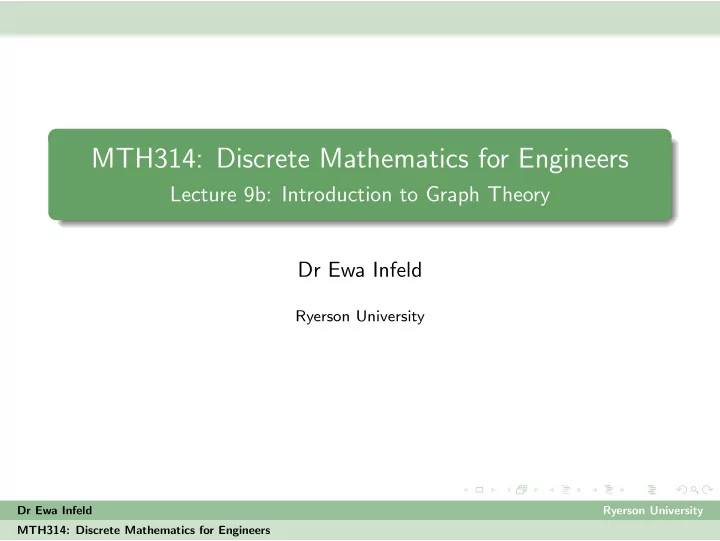

MTH314: Discrete Mathematics for Engineers Lecture 9b: Introduction to Graph Theory Dr Ewa Infeld Ryerson University Dr Ewa Infeld Ryerson University MTH314: Discrete Mathematics for Engineers
Graph Theory Basics A graph G = ( V , E ) is a data structure/mathematical object that consists of a set of vertices/nodes V and a relation E (edges) on this set. 2 V is the vertex set 3 V = { 1 , 2 , 3 , 4 , 5 } 1 E is the set of edges 4 5 Dr Ewa Infeld Ryerson University MTH314: Discrete Mathematics for Engineers
Graph Theory Basics A graph G = ( V , E ) is a data structure/mathematical object that consists of a set of vertices/nodes V and a relation E (edges) on this set. 2 1 3 4 1 3 4 2 5 5 These two are the same graph. Just two different ways to draw it. Dr Ewa Infeld Ryerson University MTH314: Discrete Mathematics for Engineers
Graph: Definition A graph G = ( V , E ) is a data structure/mathematical object that consists of a set of vertices/nodes V and a relation E (edges) on this set. Every edge e ∈ E goes between two vertices, which we call endpoints . And edge from a vertex to itself is called a loop . If there exists an e ∈ E with endpoints u , v ∈ V we say that u and v are adjacent, or that u is andjacent to v . We say that e is incident to both u and v . Dr Ewa Infeld Ryerson University MTH314: Discrete Mathematics for Engineers
Dr Ewa Infeld Ryerson University MTH314: Discrete Mathematics for Engineers
The degree of a vertex is the number of edges coming out of that vertex. A loop will count twice, since both endpoints are at the same vertex. Dr Ewa Infeld Ryerson University MTH314: Discrete Mathematics for Engineers
The degree of a vertex is the number of edges coming out of that vertex. A loop will count twice, since both endpoints are at the same vertex. 4 1 1 1 1 1 Dr Ewa Infeld Ryerson University MTH314: Discrete Mathematics for Engineers
A graph G = ( V , E ) is a simple if there are no edges from a vertex to itself (“loops”) and between any two vertices there is at most one edge. A clique is a simple graph where any two vertices are adjacent. Dr Ewa Infeld Ryerson University MTH314: Discrete Mathematics for Engineers
A graph G = ( V , E ) is a simple if there are no edges from a vertex to itself (“loops”) and between any two vertices there is at most one edge. A clique is a simple graph where any two vertices are adjacent. Not a clique: 2 3 1 4 5 For example, vertices 1 and 3 are not adjacent. Dr Ewa Infeld Ryerson University MTH314: Discrete Mathematics for Engineers
A graph G = ( V , E ) is called bipartite if there exists a partition of the set of vertices into two sets A and B , such that no two vertices in A are adjacent and no two verices in B are adjacent. 1 Dr Ewa Infeld Ryerson University MTH314: Discrete Mathematics for Engineers
A graph G = ( V , E ) is called bipartite if there exists a partition of the set of vertices into two sets A and B , such that no two vertices in A are adjacent and no two verices in B are adjacent. 1 Dr Ewa Infeld Ryerson University MTH314: Discrete Mathematics for Engineers
A graph G = ( V , E ) is called bipartite if there exists a partition of the set of vertices into two sets A and B , such that no two vertices in A are adjacent and no two verices in B are adjacent. 1 Dr Ewa Infeld Ryerson University MTH314: Discrete Mathematics for Engineers
Adjacency Matrix An adjacency matrix is an integer matrix that encodes the graph. Rows correspond to vertices, and columns correspond to vertices. i , j -entry ( i th row and j th column) is the integer representing how many edges connect vertices i and j . A B C A A 0 2 1 2 0 2 B C 1 2 0 C B In a simple graph, all entries are either 0 or 1 and all diagonal entries are 0. (why?) Dr Ewa Infeld Ryerson University MTH314: Discrete Mathematics for Engineers
Recommend
More recommend